WPWG Comics Division *poof*
Skip to commentsAs of today the comics division of the Washington Post Writers Group (WPWG) no longer exists. The distribution of the last Fort Knox comic strip for November 10, 2024 effectively shutters the comics and cartoon division of the WPWG that began in 1979. The Washington Post Writers Group itself began in 1973 as an outgrowth of The Washington Post Service syndicating newspaper columns and features.
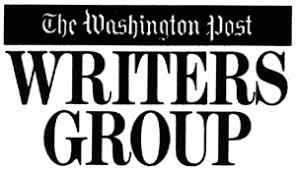
The closest I can date the debut is December 1973/January 1974. A December 24, 1973 George F. Will column is credited to “Washington Post Service,” while the January 22, 1974 Will column is credited to “Washington Post Writers Group.” The syndicate at this time has no comic strips or editorial cartoons in its offerings, though it would soon be distributing Geoffrey Moss graphics.
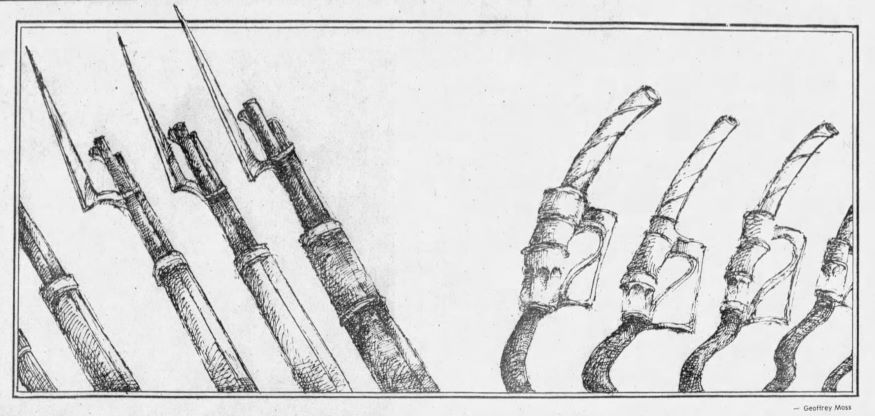
Although occasionally called editorial cartoons the Moss illustrations are more commonly called some version of what Moss himself called them: “captionless editorial graphics,” referring to himself as a “conceptual political satirist.” But they are syndicated by the WPWG and used by opinion page editors to illustrate a wide variety of related, or relatable, columns, opinions, and features.
By the late 1970s comic strips come into play thanks to The Washington Post losing the rights to Doonesbury.

In 1979 Time Inc., owner of The Washington Star, bought into Universal Press Syndicate and took G.B. Trudeau away from The Washington Post which in turn created a comic strip to replace the very popular Doonesbury.
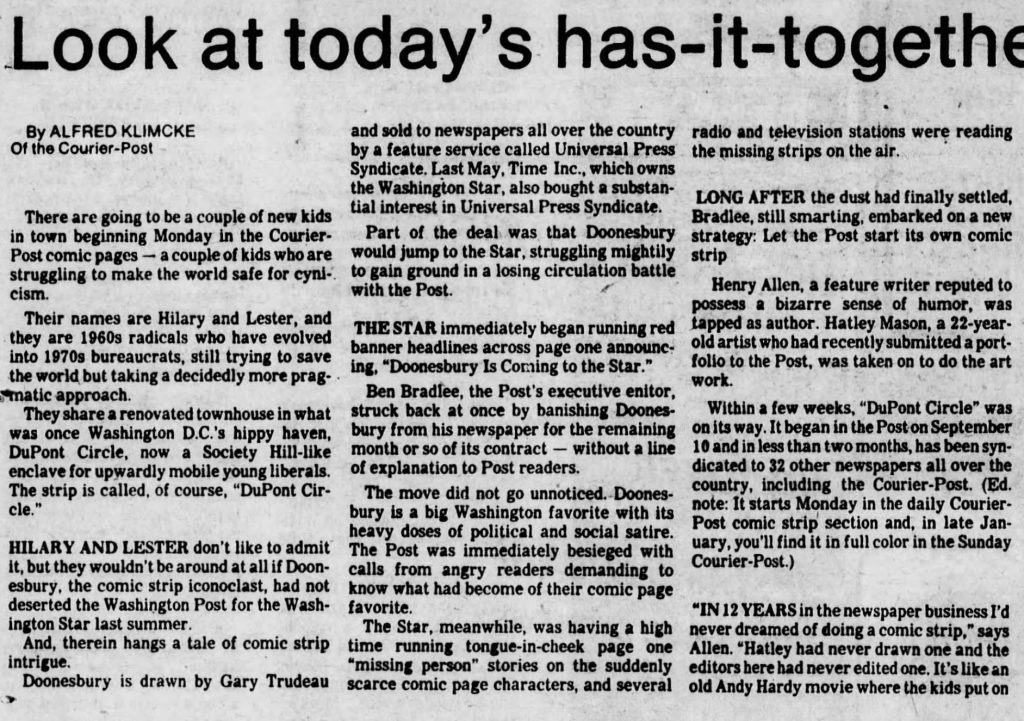
Dupont Circle would not do the trick, lasting less than a year. It wouldn’t even make it into the Washington Post Writers Group’s advertisement in the 1980 Editor and Publisher (E&P) Syndicate Directory, but it was the WPWG’s first comic strip. The 1981 E&P Syndicate Directory WPWG ad would feature their second and far more successful comic strip – one that would also be accused of being a Doonesbury simulacrum.
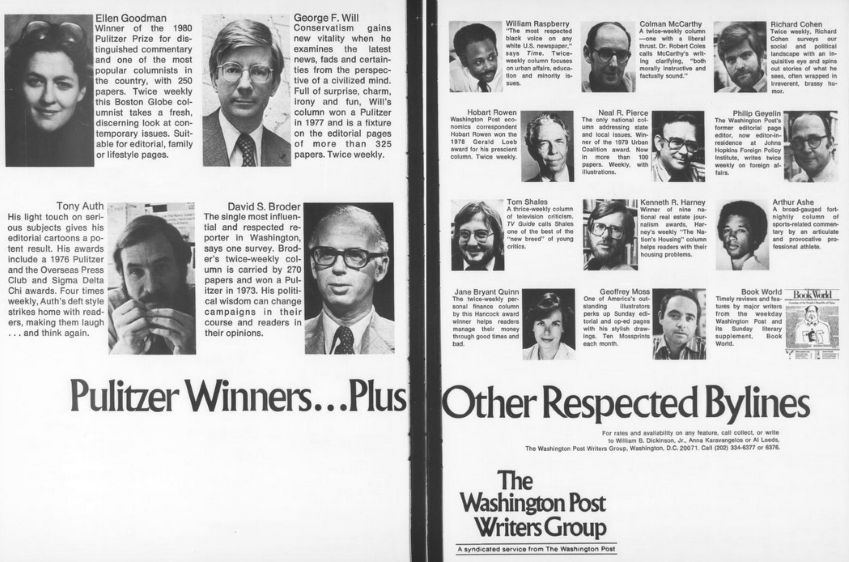
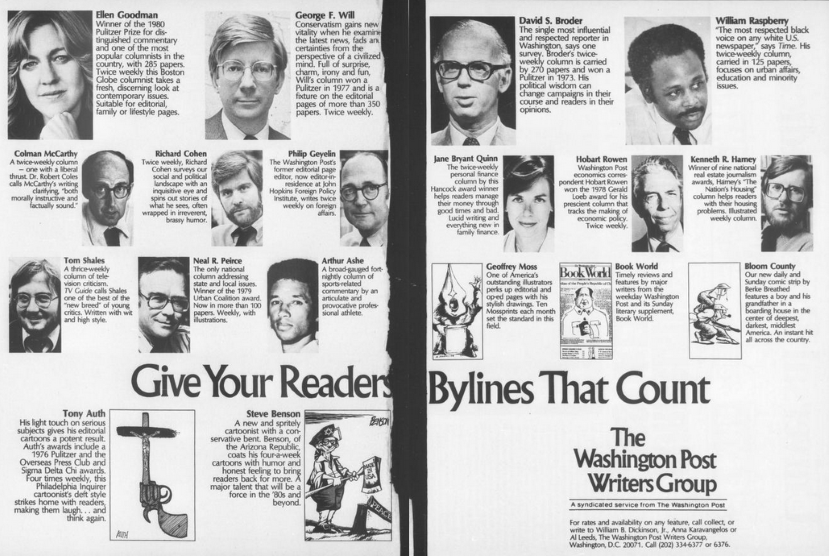
Berkeley Breathed’s Bloom County would be the WPWG’s second and most successful comic strip
As seen above the ad also promotes Geoffrey Moss’ Mossprints and two actual editorial cartoonists: The Philadelphia Inquirer’s Tony Auth and newcomer Steve Benson. Moss and Auth were also seen in the 1980 ad.
The Washington Post Writers Group never went all in for comic strips or for editorial cartoonists. The 1990 Editor and Publisher Syndicate Directory ad promoted only three comic strips and no editorial cartoonists.
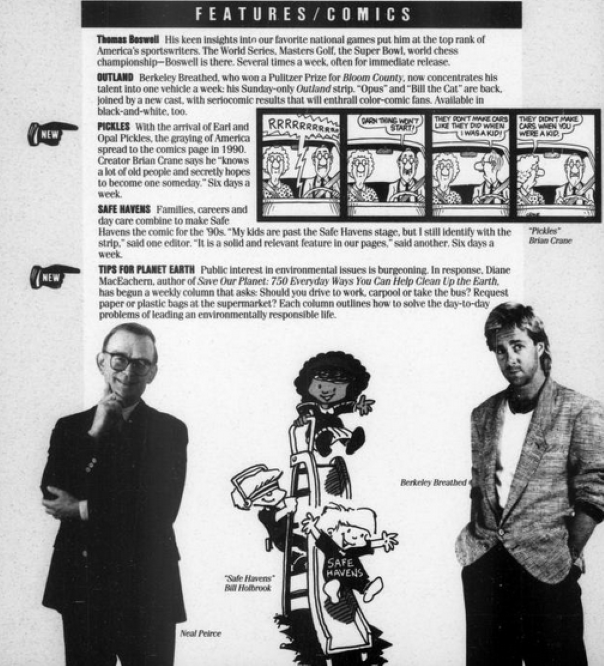
But the syndicate did carry on with respected editor Amy Lago in charge of the comics and cartoons.
Then in a surprise announcement they declared that comics and cartoons were no longer a part of their future.
The Washington Post is winding down its syndicated cartoon service

The early 2022 notice of WPWG dropping distribution of editorial cartoons was soon expanded to the comic strips when they made it known that they would not be renewing any comic or cartoon contracts, though they would honor the ones then in effect and distribute the comics until the contracts expired.
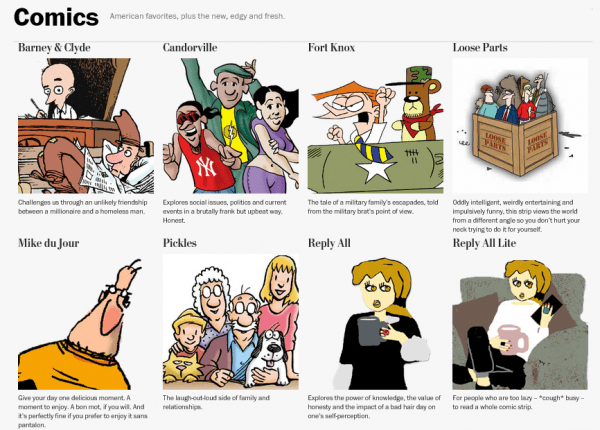
By June of 2022 the WPWG editorial cartoonists Clay Bennett, Lisa Benson, Tim Campbell, Jeff Danziger, and Jack Ohman moved en masse to the newly formed Counterpoint Media.
The comic strip creators also began moving. Dave Blazek moved his Loose Parts to Andrews McMeel in June 2022 and Brian Crane did the same the following month with Pickles. Later in July of 2022 Mike Lester took his Mike du Jour to Andrews McMeel. In November 2022 Darrin Bell moved Candorville to King Features. In 2023 Donna A. Lewis transferred Reply All and Reply All Lite to Counterpoint, as did The Weingartens and David Clark with Barney & Clyde a few months later. Rather than continue his strip Paul Jon Boscacci has decided to end Fort Knox.
Comics editor Amy Lago moved to Counterpoint with the WPWG editorial cartoonists, but kept a blue pencil at the Washington Post Writers Group until the last (Paul Jon) of the cartoonists had left See Amy’s correction in comments.
So with Fort Knox’s last strip appearing November 10, 2024 the comics/cartoon division of WPWG is closed. And The Big Five comics syndicates becomes The Big Four: Andrews McMeel Syndication, Creators Syndicate, King Features Syndicate, Tribune Content Agency, Washington Post Writers Syndicate.
With the help of Allan Holtz and Wikipedia we have a list of Washington Post Writers Group comic strips*:
Dupont Circle 1979-1980
Bloom County 1980-1989
Middle Ages 1984-1985
Cheeverwood 1985-1987
Lug Nuts 1986-1987
Safe Havens 1988-1992
Outland 1989-1995
Pickles 1990-2022
Non Sequitur 1992-1999
Cheap Thrills Cuisine 1993-2014(?)
Smart Alex 1995
PC and Pixel 1996-2008(?)

Stitches 1997-1998
Homer the Reluctant Soul 1998-1999
12:01 1999
That’s Life 1999-2005
Red and Rover 2000-2016
Out of the Gene Pool 2001-2008
Shrubbery 2002-2003
Bo Nanas 2003-2007
Candorville 2003-2022
Opus 2003-2008
Watch Your Head 2006-2014
Little Dog Lost 2007-2016

It’s All About You 2007-2010
Home and Away 2008-2015
Fort Knox 2009-2024
Barney & Clyde 2010-2023
Rudy Park 2011-2018
Reply All 2011-2023
Reply All Lite 2011-2023
Mike du Jour 2012-2022
Loose Parts 2014-2022
*dates indicates the time with the WPWG only – some comics began earlier elsewhere and many moved on afterward; dates do not include strips in rerun status
Apologies to the editorial cartoonists, I couldn’t find a comprehensive list. Along with Clay Bennett, Lisa Benson, Tim Campbell, Jeff Danziger, and Jack Ohman noted above, and Tony Auth and Steve Benson, we can add Signe Wilkinson, Mike Lester, Nick Anderson, and Darrin Bell who, at one time or another, had their political cartoons syndicated by the WPWG.
And to be clear:
Washington Post Licensing & Syndication continues with columns and features on a wide variety of subjects.
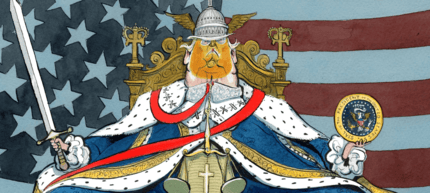

Comments 24
Comments are closed.